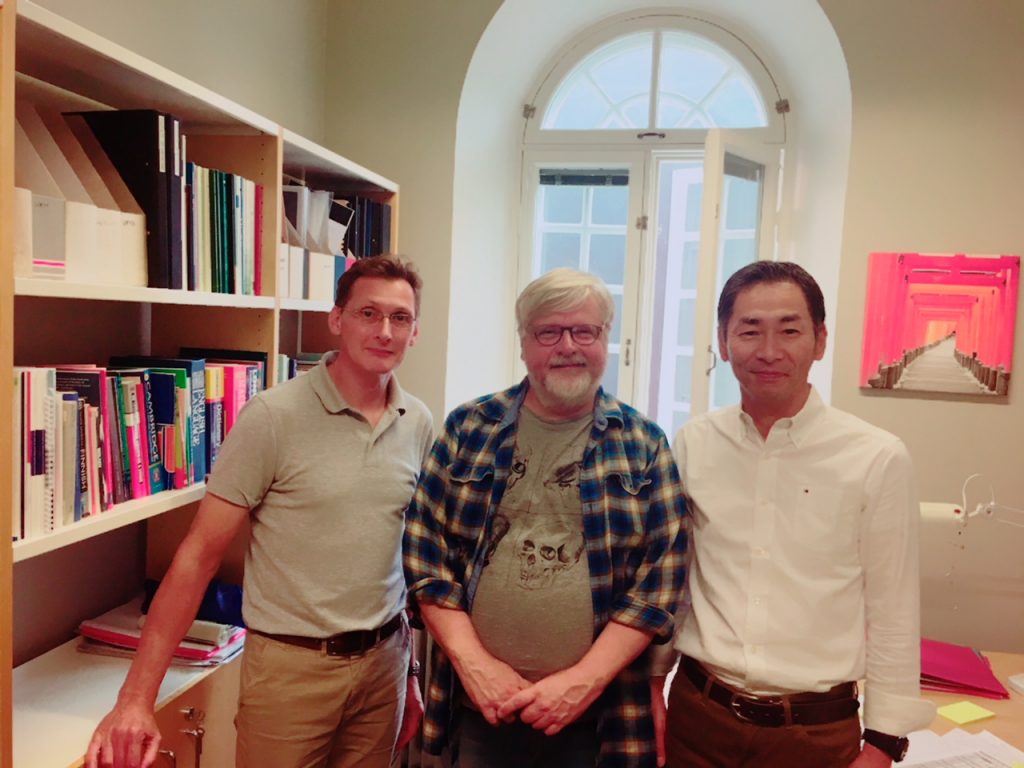
In August 2018, Professor Jun Iwata from the School of Medicine of Shimane University in Japan visited the English unit of our Language Centre on his way to Eurocall conference in Jyväskylä. As a teacher of English for medical purposes to Japanese students, he was very interested in our “Academic and Professional Communication in English” courses for the students of the Faculty of Medicine. Roy and Kari shared materials with him and discussed the similarities and differences in teaching English to medical students in Finland and in Japan. In this discussion, we covered a variety of issues including the structure and materials of our respective courses, e-learning tools used in the courses and the English language levels of our students.
Based on this discussion, and further supported by a poster presented by Holá et al. (2018) at theXV CercleS International Conference, the most striking differences are in our aims and approach to teaching the students. Namely, our approach focuses more on productive, communicative skills rather than reading and listening, grammar and lexicon.
There are several potential reasons for this, including the high starting levels of our students in their English language skills, the general availability of everyday language resources such as undubbed television programmes in English, the language of course textbooks and other materials, cultural reasons and traditions in teaching languages and what we, the language teachers, see as our function in supporting the students.
Based on Pitkänen (2018), what we do is clearly in line with both the current and future academic and professional needs of our students. We have clearly moved on from teaching medical terminology and grammar as a means to support their studies to developing their wider communicative skills English. Here in Finland, students develop their knowledge of discipline-specific terminology by reading brick-sized course textbooks in English. In Japan, medical course materials have been translated into Japanese to assist the learning process of the students. However, this means that the teaching of medical terminology in English remains the task of language teachers.
Prior to this millennium, the aims and context of English teaching in Finland resembled those of Japan. However, the role of English in Finnish society has radically changed. Instead of a focus on learning terminology and on receptive skills in general, English has now become an essential tool for academic and professional communication, and this evolution is reflected in language teaching (Pitkänen 2018).
We also have a long tradition of providing alternative means for students to acquire their English language skills (Siddall & Pitkänen 2011). Currently, this includes portfolio testing and the integration of language teaching with English-medium problem-based learning modules taught by the faculty.
What we share with Japan is the transition from using printed materials to digitalized materials. In the School for Medicine of Shimane University, online English language courses have been created in which students can collect digital badges as they complete sections within a course, and can earn a course badge when all sections are completed. The collection of digital badges enables learners to signal their personal achievement to others and motivates them to actively engage with the course (Iwata et al. 2017). Here in Helsinki, all new students in the Faculty of Medicine receive an iPad from the university for their studies, and to some extent, they also use them for developing their language skills. (Wallinheimo & Pitkänen 2016.)
As a whole, meeting language teachers from other countries provides us with an interesting window to other potential ways of fulfilling our role – and a great tool for self-reflection. Based on what we have seen, we can still feel quite good about what we have achieved so far and where we are currently heading. Naturally, we can still develop both our approaches and how we implement them in language teaching. In this, taking a closer look at what others do is extremely beneficial.
References:
Holá, Alena, Tamara Kopriková & Katja Kulhánková. Poster on “English vs Latin in ESP for Medicine presented at the XV CercleS International Conference, Poznan University of Technology, Poland, 6-8 September 2018.
Iwata, Jun, John Clayton & Sara-Jane Saravani (2017). Learner autonomy, microcredentials and self-reflection: a review of a Moodle-based medical English review course. Int. J. Information and Communication Technology 10 (1), 42-50.
Pitkänen, Kari K. 2018. From a reader/listener to a speaker/writer: Student views confirm the need to develop English courses further towards productive, interactive skills. Language Learning in Higher Education, CercleS 8(2). (445-468) https://doi.org/10.1515/cercles-2018-0023.
Siddall, Roy & Kari K. Pitkänen (2011). English by alternative means in the Faculty of Medicine. In: Out-of-Classroom Language Learning(Eds Kari K. Pitkänen, Jaana Jokinen, Sinikka Karjalainen, Leena Karlsson, Tuula Lehtonen, Mirjami Matilainen, Christian Niedling, Roy Siddall), Language Centre Publication Series vol. 2, Helsinki University Language Centre (http://hdl.handle.net/10138/25854)
Wallinheimo, Kirsi and Kari K. Pitkänen 2016: iPads in medical language courses at the University of Helsinki. Language Learning in Higher Education, CercleS 2016 6(1). (77-94) DOI 10.1515/cercles-2016-0004.
Yun’s paper
